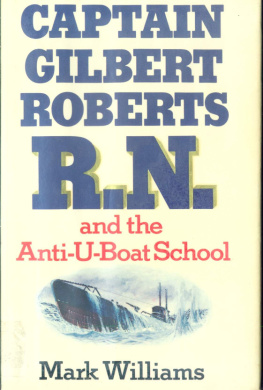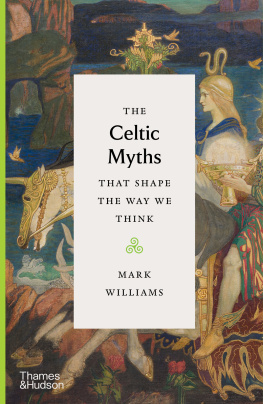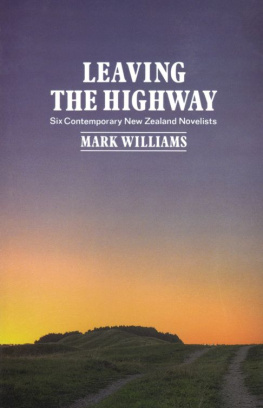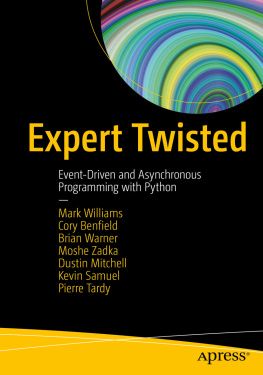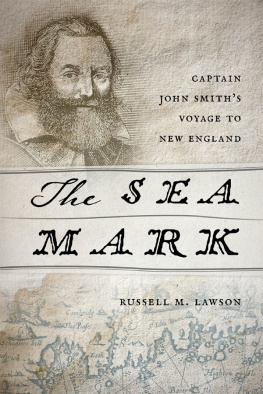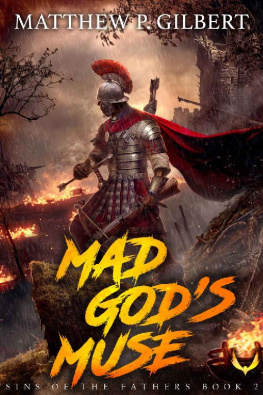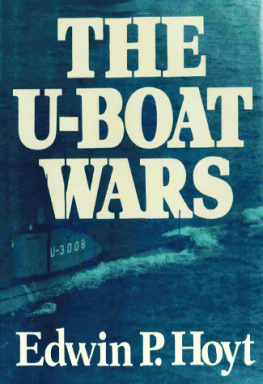Mark Williams - Captain Gilbert Roberts R.N. and the Anti-U-Boat School
Here you can read online Mark Williams - Captain Gilbert Roberts R.N. and the Anti-U-Boat School full text of the book (entire story) in english for free. Download pdf and epub, get meaning, cover and reviews about this ebook. year: 1979, publisher: Cassell, genre: Non-fiction. Description of the work, (preface) as well as reviews are available. Best literature library LitArk.com created for fans of good reading and offers a wide selection of genres:
Romance novel
Science fiction
Adventure
Detective
Science
History
Home and family
Prose
Art
Politics
Computer
Non-fiction
Religion
Business
Children
Humor
Choose a favorite category and find really read worthwhile books. Enjoy immersion in the world of imagination, feel the emotions of the characters or learn something new for yourself, make an fascinating discovery.
- Book:Captain Gilbert Roberts R.N. and the Anti-U-Boat School
- Author:
- Publisher:Cassell
- Genre:
- Year:1979
- Rating:3 / 5
- Favourites:Add to favourites
- Your mark:
- 60
- 1
- 2
- 3
- 4
- 5
Captain Gilbert Roberts R.N. and the Anti-U-Boat School: summary, description and annotation
We offer to read an annotation, description, summary or preface (depends on what the author of the book "Captain Gilbert Roberts R.N. and the Anti-U-Boat School" wrote himself). If you haven't found the necessary information about the book — write in the comments, we will try to find it.
Captain Gilbert Roberts R.N. and the Anti-U-Boat School — read online for free the complete book (whole text) full work
Below is the text of the book, divided by pages. System saving the place of the last page read, allows you to conveniently read the book "Captain Gilbert Roberts R.N. and the Anti-U-Boat School" online for free, without having to search again every time where you left off. Put a bookmark, and you can go to the page where you finished reading at any time.
Font size:
Interval:
Bookmark:
In late August, 1943, nine U-boats sailed from Germany for the North Atlantic, armed for the first time with a new weapon. Each submarine carried five acoustic homing torpedoes known as T5, designed primarily to attack convoy escorts. In the first week of September, thirteen more U-boats armed in a similar manner sailed for the same destination from Biscay ports. With the exception of U.669 which was sunk by 21 Wellington aircraft, all arrived at their patrol points. A new phase in the Battle of the Atlantic was about to begin.
Potentially this new weapon could finally and totally swing the tide of the Atlantic battle in favour of Germanya battle that had earlier come appallingly close to defeat for Britain and her allies. Defeat had indeed stared Britain in the face in late 1941 and 1942. Survival had been estimated in days at the continuing horrendous losses of shipping, vital supplies and seamen. The situation led Winston Churchill to comment after final victory: The only time I knew real fear was during the Battle of the Atlantic!
Lack of escorts, training and tactics were the contributing factors in the adverse sway against the Allies. In January, 1942, Winston Churchill sent for a British Naval officer and told him to go to Liverpool, form a school of tactics and training and evolve methods to protect the convoys and sink the U-boats. This officer, bewildered at, his appointment, distressed at the news that the war was being lost, proceeded to Liverpool and with string, chalk and canvas constructed the Western Approaches Tactical Unit in the bomb-damaged top wing of the Tate and Lyle Exchange Buildings.
Within six weeks the first anti-U-boat tactic, codenamed Raspberry, was in operation in the Atlantic and seventeen- and eighteen-yearold Wrens were teaching tactics to Group Leaders, escort commanders and watchkeeping officers. Altogether over 5,000 officers of the R.N., R.N.V.R., R.N.R., Dutch, Norwegian, French, Polish and Commonwealth officers attended the courses in anti-U-boat warfare. Throughout 1942 and 43 W.A.T.U. evolved tactics, continuously up-dating convoy defence and successfully combating the changing attacks of the U-boat. The convoys were getting through with their supplies, U-boats were being sunk. Time had been boughttime in which increasing numbers of escorts were built and their crews trained.
Science came to the aid of the U-boat command and the acoustic homing torpedo was designed and tested. So it was, in early September, 1943, that twenty-one U-boats each with 5 T.5s awaited their prey. Fate decreed that two outward bound convoys (UK to North America) ONS.18 of twenty-seven ships escorted by B3 Group and ON.202 of forty ships escorted by C2 Group, would join up and be the target for a new U-boat offensive.
The full story of this epic encounter is told in later chapters, for this introduction the basic facts will suffice. Because of Admiralty intelligence reportings of U-boat activity, the two convoys were ordered to join up. The 9th escort group was additionally ordered to rendezvous with the now larger convoy and altogether sixty-seven merchant ships I with nineteen escorts finally grouped up and sailed on. Within hours the U-boats attacked, their targets the escorts, with the intention of engaging the almost unarmed merchant ships with their guns once the escorts were out of the way.
Within two days of the ensuing battle, the escorts Escapade and Lagan were severely damaged and had to return to port; St Croix, Polyanthus and Itchen were sunk. Of the U-boats U.341, U.338, U.229 were sunk and U.386 and U.270 damaged. Four merchant vessels were torpedoed.
From the battle reports flowing into the Western Approaches war-room, the Director of the W.A. Tactical Unit deduced that the German U-boat command had solved the technical problems in producing an acoustic torpedo and, purely from the brief messages received, took on the problem of evolving a tactic against acoustic torpedo attack. On the floor of the Western Approaches Tactical Unit, the problem was presented in chalk, the reported manoeuvres repeated. A counter measure was evolved and tested. Again and again it workedon the floor of the tactical school! Within hours the answer had been found and the tactic Step-aside was signalled to all escorts.
So quickly, in fact, did W.A.T.U. work at solving the problem, that the frigate Orchis received the tactic on jury-rigged aerials a few hours after Itchen had blown up almost alongside her after the two frigates had chased a U-boat through the convoy and Itchen had been the unlucky one to collect an acoustic torpedo. Following that signalled tactic, Step-aside, no more escorts were sunk or damaged by acoustic torpedoes. Later foxers gave further immunity from attack, although many escort commanders relied on Step-aside for protection.
Such an action typified the work of the Western Approaches Tactical Unit, a unit on which Winston Churchill placed such responsibility, and of the Naval Officer who formed the unit and remained its Director until the end of the war. His tactical brilliance later included other theatres of war. What sort of man so justified Winston Churchills trust; his Commander-in-Chiefs complete confidence; our allies gratitude? In January, 1942 when Churchill sent for him, he was a commander aged forty-one who had been retired from the Royal Navy in 1938 with T.B., contracted whilst Captain of the destroyer Fearless during the Spanish Civil War. And to whom the Admiralty had written on the 2nd November, 1939:
...you will not be accepted again for general service in the Royal Navy. I am to state that it is very unlikely that any suitable service could be found for you...
Unlikely any suitable service... This officer completed his fifty years service with the Royal Navy in 1964. In the course of such service he had been awarded the C.B.E.: and our allies gave him the Knight Commanders Order of St Olav of Norway; The Commanders Order of Polonia Restituta of Poland and the Officers Order of the Legion of Honour of France.
To this officer, the wartime First Lord of the Admiralty, A. V. Alexander, wrote:
...it must be a source of great satisfaction to you and your staff at the success achieved against the-varying methods of enemy attack. I shall always feel personally indebted to you for your initiative and leadership and particularly for your unfailing enthusiasm in spite of your ill health.
This book then is the story of this officerhis career and service that spanned fifty years, from 1913-1964, often in unusual but always interesting circumstances. Outspoken, dogmatic, articulate, a man whose burning desire to be of service to the Crown fought against prejudice and ill health.
This is the story of Captain Gilbert Howland Roberts, C.B.E., R.D., R.N. and his tactical battles against the U-boats.
OsborneHibernia
DartmouthCollingwood
In a spacious high-ceilinged room in the Admiralty on a summers day in 1913, an Interview Board was being held. Their Chairman was a uniformed, frock-coated Vice-Admiral, a uniformed Captain was by his side and a gowned headmaster, a civilian doctor and a civil servant clerk completed the Admiralty side. Across the highly polished mahogany table, with its strip of green baize and heavy silver ornaments, stood, ramrod-stiff, a twelve-year-old dark-haired boy dressed in the uniform of Westminster School. An enormous black eye covered the right side of the boys face with vivid red marks tracing down his cheek and neck until further masked by the white collar he wore. The Admiral gazed in astonishment at the black eye.
Sit down, Roberts.
Thank you, sir. Master Roberts sat forward, bolt upright on the chair provided.
Font size:
Interval:
Bookmark:
Similar books «Captain Gilbert Roberts R.N. and the Anti-U-Boat School»
Look at similar books to Captain Gilbert Roberts R.N. and the Anti-U-Boat School. We have selected literature similar in name and meaning in the hope of providing readers with more options to find new, interesting, not yet read works.
Discussion, reviews of the book Captain Gilbert Roberts R.N. and the Anti-U-Boat School and just readers' own opinions. Leave your comments, write what you think about the work, its meaning or the main characters. Specify what exactly you liked and what you didn't like, and why you think so.

